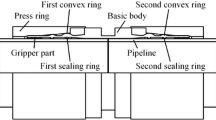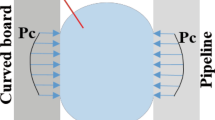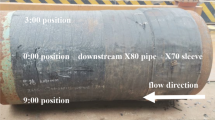Abstract
In order to improve reserves and production, the oil and gas fields underground exploit environment is becoming increasingly harsh. Due to frequent cyclic dynamic loading condition, the completion casing leakage accidents happened frequently in high-pressure gas well, which proved that the existing methods cannot meet the production needs. Meanwhile, the various gas-sealed threaded joints have great differences in bearing compressive capacity in the market. Therefore, the structural strength and the sealing design should be taken into considered in completion well with cyclic dynamic loads. Taking gas storage wells with intensive injection and production as an example, the maximum axial loads produced by multi-factors are analyzed, and the design criteria of completion casing under cyclic dynamic load are put forward in combination with the tension and compression efficiency of gas-sealed threaded joints. A new “strength + sealing” design method of the pipe string under alternating load changing was established. This method has been incorporated into the industry standards which has been applied in the design of pipeline string in cyclic operation environments in Hutubi, Wen23 cases, etc.
Access provided by Autonomous University of Puebla. Download conference paper PDF
Similar content being viewed by others
Keywords
Faced with the international situation of low oil price and the contradiction between supply and demand of oil and gas resources, the Ministry of Land and Resources has put forward the strategic policy of reducing cost and increasing efficiency in oil and gas field. For the harsh storage conditions of oil and gas such as “low permeability, deep/ultra-deep formation, ocean, unconventional” and the characteristics with difficult exploitation, variable load and high casing damage rate, this put forward higher requirements for the design and evaluation methods of oil and casing strings, such as Cyclic dynamic loading environment of frequent switching of gas wells, acidification/multi-stage fracturing, steam huff and puff, and strong injection and production, Among them, the most prominent feature is the strong injection and production of gas storage.
The stress of completion string of underground gas storage is different from common gas well string [1, 2]. Its main characteristics are load alternation and pressure fluctuation. The traditional string design method is still used in completion string design [3, 4], which leads to completion string leakage of in the later stage of operation, then fatigue failure. At present, the most direct characterization phenomenon is the pressure in the annulus of the oil sleeve [1], which results in gas leakage at wellhead and surface, seriously endangering the safety of gas storage and the surrounding environment. Traditional string design mainly focuses on the design of tension resistance, internal pressure resistance and compression resistance. It improves the failure resistance of injection-production string by improving the mechanical properties, wall thickness and gas-sealed threaded structure [5,6,7,8,9]. However, the results show that the design methods are not applicable to completion string and can not decrease the occurrence of damage. The paper analyzed the load variation during the whole process of construction and operation of gas storage completion string. Considering the sealing performance of joints, and combined with the full-scale physical simulation test results, a new design method of well completion is proposed in cyclic alternating load.
1 Limit Load Analysis of Completion String
At the beginning of the design, the strength of gas storage completion string was designed to meet the standard requirements. Now, selecting two gas storage wells by their respective operating conditions (Table 1) to calculate the maximum tensile and compressive load of the completion string under cyclic alternating conditions (Table 2) according to the theory of string mechanics [10,11,12,13], which are far lower than the rated tensile strength of the string. It shows that the design of tensile strength of pipe string is safe. If further compared with the rated tensile strength, the required joint tension efficiency and compression efficiency of the completion string under operation conditions can be obtained (Table 2).
From the Table 2, the tension and compression efficiency of the gas-sealed threaded joints of the completion string in well 1 of gas storage are much lower than the rated value under the operation conditions; the tension efficiency of the gas-sealed threaded joints of the completion string in well 2 of gas storage is lower than the rated value under the operation conditions, but the compression efficiency under the operation conditions is higher than the rated value and there is a risk of leakage. In the actual operation process, annulus pressure occurs in well 2 of gas storage, and well 1 of gas storage is safe to operate.
2 Design Criteria for Sealing of Completion String
According to the above analysis, the tension efficiency and compression efficiency of the selected gas-sealed threaded joint of completion string should meet the requirements of operation conditions. Therefore, in order to determine the gas-sealed threaded joints suitable for completion string under cyclic alternating load and to ensure the sealing integrity, based on the strength design of the pipe string, the following sealing design criteria are defined:
where, \( \updelta_{\text{t}} \), \( \updelta_{\text{c}} \) are tension and compression efficiency of gas-sealed threaded joints respectively; \( {\text{T}}_{\text{to}} \), \( {\text{T}}_{\text{co}} \) are tensile yield load and compression yield load of pipe body respectively, which are generally equal to the rated tensile strength \( {\text{T}}_{\text{O}} \) of pipe body; \( {\text{T}}_{\text{atmax}} \) and \( {\text{T}}_{\text{acmax}} \) are the maximum tension load and compression load of injection-production pipe string during injection-production operation; \( {\text{S}}_{\text{tt}} \) is the tensile safety factor of pipe string joint. The minimum is 1.30; \( {\text{S}}_{\text{tc}} \) is the compression safety factor of the tubular joint, and the minimum is 1.00.
Formulas (1) and (2) are used to analyze the data of Table 2 again. The safety factor of the gas-sealed threaded joints used in Well 1 of the gas storage is over 1.40, and the safety margin is high. The tensile safety factor of the gas-sealed threaded joints used in Well 2 of the gas storage is 1.45, which is higher than the prescribed safety factor, but the compression safety factor is 0.70, which is much lower than the prescribed value, so the gas seal selected in Well 1 of the gas storage. Threaded joints are not suitable for this operation condition.
Therefore, the selection of gas-sealed threaded joints must meet the requirements of Formulas (1) and (2) at the same time in order to ensure the integrity of the string seal.
3 Test Verification and Evaluation
In order to verify whether formulas (1) and (2) are suitable for sealing design of tubular threaded joints and to verify the correctness of the two formulas. On the basis of ISO 13679 standard [14], combined with the operation conditions of injection - production in gas storage wells in Table 1, the test sealing performance of 30-week gas-sealed threaded casing under alternating tension and pressure load Using an improved experimental procedure.
Take the P110 steel grade \( {\emptyset } \)114.3 × 6.88 mm sealing joint as an example. The specimen was stretched 85% to 60% compression to 85% tension in 50 MPa internal pressure. After 30 cycles, no leakage occurred (Fig. 1), and the test load was higher than the operating load, which ensured a certain safety margin.
Selection of \( {\emptyset } \)114.3*6.88 mm L80 G buckle tubing string. The specimen was stretched 85% to 35% compression to 85% tension in 50 MPa internal pressure. After 21 cycles, no leakage occurred. After that, the sample was subjected to 85% tension to 40% compression to 85% tension under 50 MPa internal pressure, and leaks occurred after seven cycles (Fig. 2). That is to say, the 21 gas seal cycle tests in low rated compression efficiency did not leak, However, when increasing compression load to rated compression efficiency, leakage occurs only after 7 cycles, failing to complete 30 cycles of gas seal cycle test.
Figures 1 and 2 show that there was no leakage during 30 cycles of gas seal test under the rated tensile and compression efficiency of the joints, leakage occurs easily if the rated compression efficiency is higher or equal to the rated compression efficiency of the joints. This further confirms the rationality of formulas (1) and (2) of sealing design criteria.
4 Conclusion
(1) The selection of gas-sealed threaded joints for gas storage completion string must consider the variation load. The gas-sealed threaded joints with corresponding performance should be selected according to the maximum tensile load and compressive load.
(2) According to the load variation of the completion string and the actual performance of the joint, the design criterion for the sealing of the completion string is put forward. The rationality of the criterion is verified by gas seal cycle test, and it is consistent with the actual situation in the field.
(3) The completion string design under cyclic alternating load should be based on the strength design, and the sealing design of completion string should be further carried out, selecting suitable gas-sealed threaded joints to ensure the completion string sealing integrity.
(4) Completion string sealing design criteria can be used for cyclic dynamic loading environments in downhole such as gas wells frequent switching, acidification/multistage fracturing, steam huff and puff, strong injection and strong production, etc.
References
Ding, G., Li, C., Wang, J., et al.: The status quo and technical development direction of underground gas storages in China. Nat. Gas. Ind. 35(11), 107–112 (2015)
Wang, J., Sun, J., Xue, C., et al.: Optimization of gas-tight thread connection on the injection-production strings in underground gas storage weells. Nat. Gas. Ind. 37(5), 76–80 (2017)
National Development and Reform Commission: SY/T 5724-2008 Design for Casing String Structure and Strength. Petroleum Industry Press, Beijing (2008)
International Organization for Standardization: Petroleum and Natural Gas Industries—Equations and Calculations for the Properties of Casing, Tubing, Drill Pipe and Line Pipe used as Casing or Tubing: ISO/TR10400—2004. International Organization for Standardization, Geneva (2007)
Wang, J., Feng, Y., Yan, X., et al.: Strength reduction factor of high-grade steel casing strings at high temperature. J. Univ. Sci. Technol. Beijing 33(7), 883–886 (2011)
Wang, J., Feng, Y., Luan, Z., et al.: Analysis of tubing collapse failure during the operation of blending light dropping viscosity. Appl. Mech. Mater. 184, 719–723 (2012)
Klever, F.J., Tamano, T.: A new OCTG strength equation for collapse under combined loads. In: Proceedings of SPE Annual Technical Conference and Exhibition, Houston, TX, September 2004, SPE Drilling & Completion, September 2006. SPE 90904
Urband, B., Bernard, F., Morey, S., et al.: Latest Enhancements in High Strength Sour Service Tubular (2009). SPE/IADC 119888
API Spec 5CT: Specification for Casing and Tubing, 8th edn. API, Washington DC (2005)
Han, Z.: Tubing String Mechanics in Hydraulic Environment. Petroleum Industry Press, Beijing (2011)
Gao, B., Gao, D.: A new method for testing tubing axial load in high-pressure and high-temperature wells. J. Univ. Petrol. China 26(2), 39–41 (2002)
Editorial Committee of Offshore Oil and Gas Field Completion Handbook. Offshore Well Completion. Petroleum Industry Press, Beijing (1998)
National Energy Administration: SY/T 7370-2017 Recommended Practice for Selection and Design of the Injection-Production Tubing String in Underground Gas Storage Well. Petroleum Industry Press, Beijing (2017)
International Organization for Standardization: Petroleum and Natural Gas Industries—Procedures for Testing Casing and Tubing Connections: ISO 13679—2002. International Organization for Standardization, Geneva (2002)
Acknowledgments
The project is supported by the Natural Science Foundation of China (U1762211), National key Technologies R&D Program of China (2016ZX05022-005, 2017ZX05009003-004), CNPC Basic Research Project (2019A-3911) and Shaanxi Outstanding Youth Fund (2018JC-030).
Author information
Authors and Affiliations
Corresponding author
Editor information
Editors and Affiliations
Rights and permissions
Copyright information
© 2020 Springer Nature Singapore Pte Ltd.
About this paper
Cite this paper
Wang, Jj., Yang, Sy., Sun, Jh., Chi, M., Zhang, L. (2020). Completion String Seal Design Method with Cyclic Alternating Load. In: Lin, J. (eds) Proceedings of the International Field Exploration and Development Conference 2019. IFEDC 2019. Springer Series in Geomechanics and Geoengineering. Springer, Singapore. https://doi.org/10.1007/978-981-15-2485-1_262
Download citation
DOI: https://doi.org/10.1007/978-981-15-2485-1_262
Published:
Publisher Name: Springer, Singapore
Print ISBN: 978-981-15-2484-4
Online ISBN: 978-981-15-2485-1
eBook Packages: EngineeringEngineering (R0)






